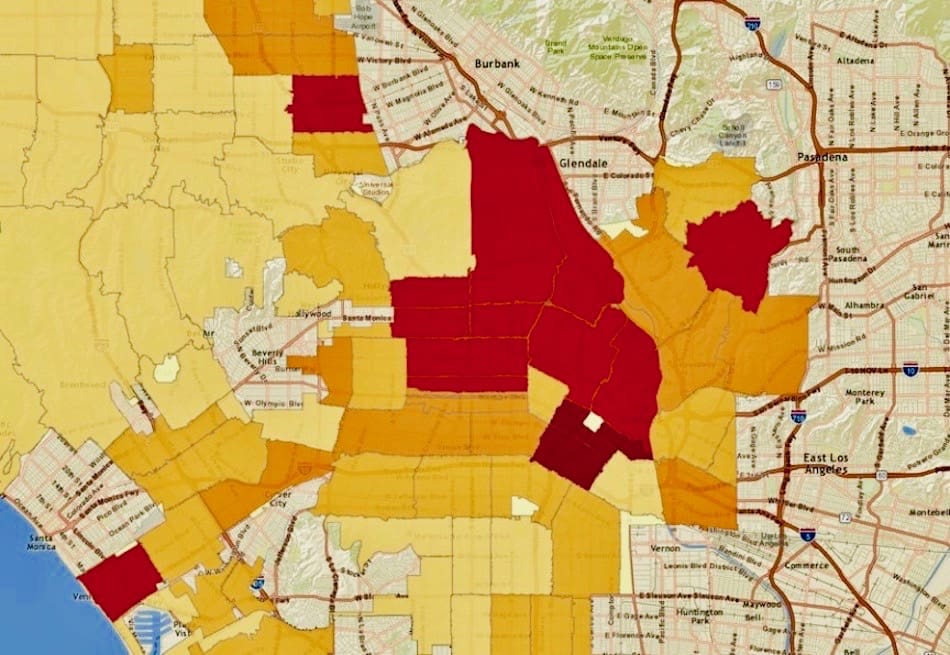Backing up what residents and activists have long seen unfolding, a City Hall database reveals that a devastating gentrification crisis is sweeping across Los Angeles. The information was collected, with little public knowledge, by Mayor Eric Garcetti’s Los Angeles Innovation Team.
In 2016, with funding from Bloomberg Philanthropies, Garcetti’s Innovation Team, or “i-team,” created databases that measure gentrification and displacement in L.A.: the Index of Neighborhood Change and the Index of Displacement Pressure. The indexes, though, have existed in near obscurity for a year. Housing Is A Human Right, the housing advocacy division of AIDS Healthcare Foundation, is now bringing the largely undisclosed data to the public.
The neighborhood change index ranks gentrification in 111 communities based on zip codes — Downtown L.A. is the most gentrified; Bel Air ranks 111. The i-team notes that the rankings are based on six “demographic measures indicative of gentrification.”
In a June 2017 article, Harvard’s Data-Smart City Solutions praised the i-team’s databases as valuable tools to help policymakers and residents come up with data-driven anti-gentrification and anti-displacement interventions. So far, L.A. politicians have done little, if anything, with the city data.
In the meantime, luxury-housing development, which contributes to the gentrification of neighborhoods, continues to be approved by the L.A. City Council and mayor for working- and middle-class communities such as Westlake, Hollywood, and Historic South-Central.
The Top 10 list shows that lower- and middle-income people of color and immigrants are suffering the worst in L.A.’s most gentrified areas. Lower- and middle-income whites are also enduring hardships.
Activists widely agree that L.A.’s gentrification crisis is fueling a three-pronged emergency of record-high evictions, skyrocketing rents, and record-breaking new homelessness.
Angelenos are deeply concerned. On December 2, in Leimert Park, more than 800 people attended the Resist Gentrification Action Summit, which was organized by Housing Is A Human Right, Alliance of Californians for Community Empowerment-Los Angeles, CDTech, Eviction Defense Network, and more than 40 other groups.
Predictably, Downtown, Hollywood, Westlake, and Venice appear in the top 10. What may be surprising is that the San Fernando Valley area of North Hollywood/Valley Village/Toluca Lake is ranked 12 — a fact that further demonstrates that L.A.’s gentrification crisis is widespread.
Here are L.A.’s top 10 most gentrified communities. The list includes demographics from the Los Angeles Times’ “Mapping L.A.” database. The Times used data from the 2000 U.S. Census.
- Downtown: where lower-income Asians, Latinos, and African Americans made up the majority of the population;
- Arts District/Downtown: again, where lower-income African Americans, Latinos, and Asians made up the majority of the population;
- Westlake (and part of Downtown): where lower-income Latinos and Latino immigrants overwhelming made up the majority of the population;
- Pico Union (and part of Downtown): where lower-income Latinos and Latino immigrants overwhelming made up the majority of the population;
- Silver Lake/Echo Park/Westlake: where lower- and middle-income Latinos, Asians, and whites made up the population;
- Hollywood, between Franklin and Fountain avenues: where lower-income Latinos and whites largely made up the population;
- Chinatown/Arts District: where lower-income Asians and Asian immigrants overwhelming made up the population;
- Another section of Hollywood, between Fountain and Melrose avenues;
- Venice: where middle-income whites, African Americans, and Latinos made up the population;
- East Hollywood and part of Silver Lake: where lower-income Latinos overwhelmingly made up the population, along with lower-income Asians and whites.
Additionally, the area of Silver Lake/Atwater Village/Elysian Valley/Echo Park is ranked 11, North Hollywood/Valley Village/Toluca Lake is 12, Los Feliz is 13, Highland Park/Montecito Heights is 14, and Larchmont Square/East Hollywood is 15.
Go to the Los Angeles Index of Neighborhood Change to see what’s happening in your neighborhood.
Follow Housing Is A Human Right on Facebook and Twitter.
Above map from L.A. Index of Neighborhood Change

